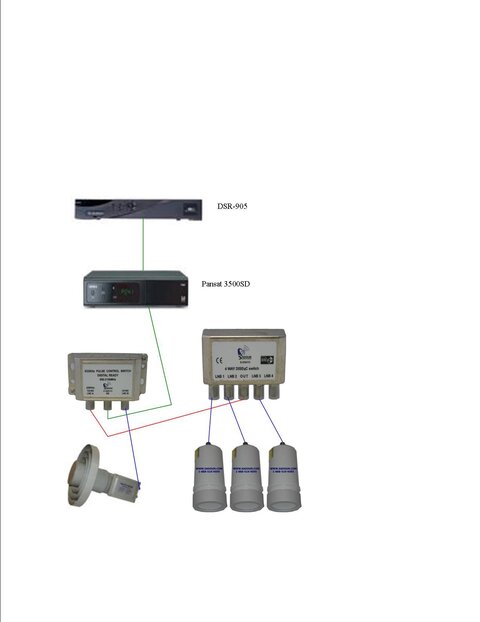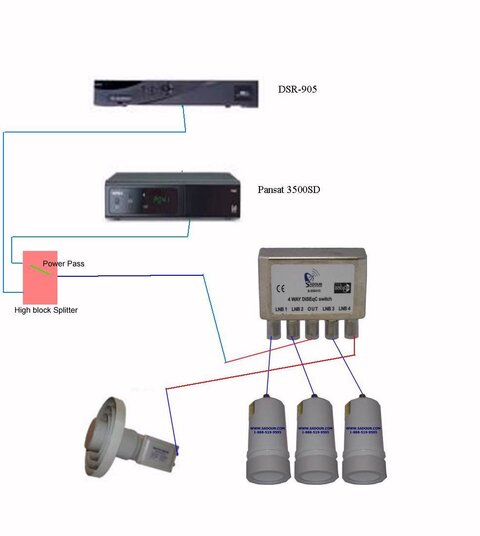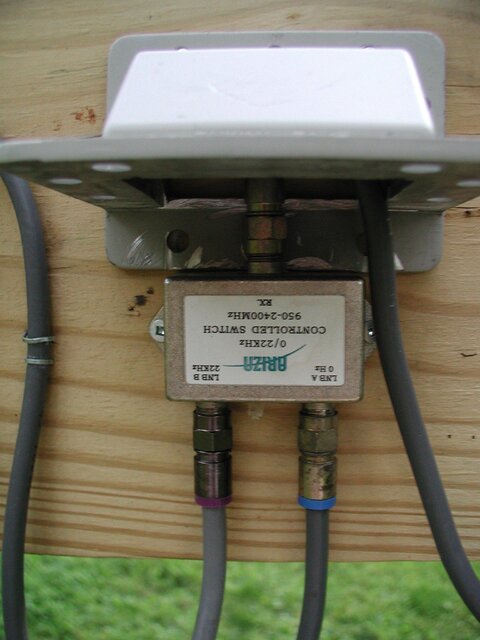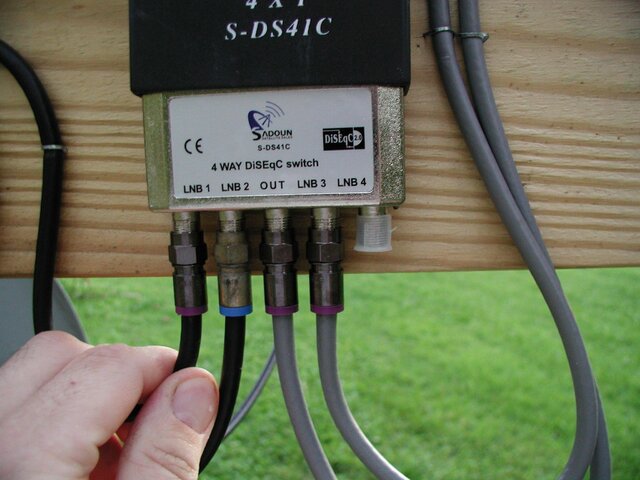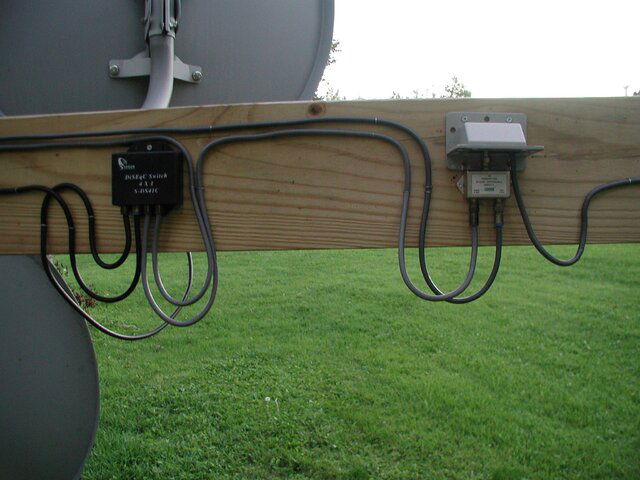Any reason why this would not work?
- Thread starter Inno
- Start date
- Latest activity Latest activity:
- Replies 22
- Views 3K
You are using an out of date browser. It may not display this or other websites correctly.
You should upgrade or use an alternative browser.
You should upgrade or use an alternative browser.
- Status
- Please reply by conversation.
Why not just hook the c band lnbf on the diseqc? Thats how my 3 ku lnb's and 1 c band lnb is hooked up.
EDIT
Now that I think about it you may have to do it this way since the 905 cannot handle diseqc. The 3500 will control polarity.
EDIT
Now that I think about it you may have to do it this way since the 905 cannot handle diseqc. The 3500 will control polarity.
Attachments
Last edited:
If the 22khz switch were an Ecoda, it would work.
Or, you could leave out the 22khz switch, and hook the C-band LNBF to the spare input on your 4x1 diseqc switch.
Here's a similar idea, all fleshed out, in the Switches Simplified FAQ.
It uses two 4x1 diseqc switches, selected by a 22khz ecoda.
edit:
Looks like I type too slow.
Or, you could leave out the 22khz switch, and hook the C-band LNBF to the spare input on your 4x1 diseqc switch.
Here's a similar idea, all fleshed out, in the Switches Simplified FAQ.
It uses two 4x1 diseqc switches, selected by a 22khz ecoda.
edit:
Looks like I type too slow.
Are you using that shown 22kHz switch? or an Ecoda?Here is a pic of the way I have things hooked up. Can anyone tell me if they see any reason why it might not work properly? This is not a trick question, I'm really not sure.
The Ku LNBs are all standard and the C-Band is a single output LNBF.
After I read TVROPro's EDIT, I saw another problem.
I couldn't use the LOOP OUT on the Coolsat 6000 when I went to slave the DSR-922.
I wanted to make sure the DSR-922 worked correctly in DC2 mode.
The only DC2 Ku signal at the time was OETA, Oklahoma PBS on 79W
My father's motor was the only dish I could use to hit it at the time.
Everytime I would apply power to the DSR-922 while looped through the LOOP OUT, the Coolsat 6000 would power off immediately.
I barely understand electrical matters, but the short version is that hooking the DSR-922 through the LOOP OUT tripped the Coolsat's Voltage protection EVERY TIME
Inno, care to be more clear about what doesn't work?
I couldn't use the LOOP OUT on the Coolsat 6000 when I went to slave the DSR-922.
I wanted to make sure the DSR-922 worked correctly in DC2 mode.
The only DC2 Ku signal at the time was OETA, Oklahoma PBS on 79W
My father's motor was the only dish I could use to hit it at the time.
Everytime I would apply power to the DSR-922 while looped through the LOOP OUT, the Coolsat 6000 would power off immediately.
I barely understand electrical matters, but the short version is that hooking the DSR-922 through the LOOP OUT tripped the Coolsat's Voltage protection EVERY TIME
Inno, care to be more clear about what doesn't work?
I wasn't sure if Inno was turning off the 3500, or using it to control the switches and polarity.Now that I think about it you may have to do it this way since the 905 cannot handle diseqc. The 3500 will control polarity.
But, if the switches are wired right, the default power-on mode -could- be such that the C-band LNB is selected and passes through to the 905.
And now that I think about it, if the 3500 left the switches selecting a Ku LNB, that could be hard to deselect by the 905, without turning both receivers off.
A minor situation, easily worked around, but if it's a problem that just never comes up, so much the better. -
Any ideas?
My intent was just to turn off the 3500 to use the 905 and this does work to control the polarity of the C-Band LNBF.
The reason for the 22khz switch is twofold. First because the 905 does not do diseqc and second because I plan on adding more to it at a later time.
I did look at Anole's diagrams in the FAQs section and it was my understanding that the Ecoda switch was only necessary when using Universal LNBs to pass the 22khz info to the LNBs. In my case with standard LNBs, it is not necessary? Mine is NOT the Ecoda.
The reason I am asking is that for some reason I am not getting the correct Ku signals in the house. For example last week I went out and tuned one of the Ku dishes to AMC15 to do some feed hunting. I found the signal out at the dish with my Coolsat 5000 but when I connected the switches back up and tried with the Pansat in the house I could not get any quality at all. This LNB is connected to diseqc #3. The dish hooked to diseqc #1 seems to work fine but it is not switching properly.
The diseqc switch was replaced earlier in the year because of a similar problem but I really did not use the Ku stuff all summer due to other things that kept me busy. The 22khz switch does work as I tried putting the C-band LNBF on the 22khz side and went into the hidden menu of the 905 and turned on the 22khz tone and I did get good signal.
Now I'm kinda stumped. I was wondering if it was my configuration or if I have something else wrong. I need to chase some wires because I think there is perhaps one coupler somewhere in the basement and possibly some RG-59 (ugh!!). The previous owner of the house ran a LOT of RG-59 and in some cases I used it because it was easier than running new stuff but it looks like maybe that's gonna come back and bite me in the butt. Time to chase some wires!
The reason for the 22khz switch is twofold. First because the 905 does not do diseqc and second because I plan on adding more to it at a later time.
I did look at Anole's diagrams in the FAQs section and it was my understanding that the Ecoda switch was only necessary when using Universal LNBs to pass the 22khz info to the LNBs. In my case with standard LNBs, it is not necessary? Mine is NOT the Ecoda.
The reason I am asking is that for some reason I am not getting the correct Ku signals in the house. For example last week I went out and tuned one of the Ku dishes to AMC15 to do some feed hunting. I found the signal out at the dish with my Coolsat 5000 but when I connected the switches back up and tried with the Pansat in the house I could not get any quality at all. This LNB is connected to diseqc #3. The dish hooked to diseqc #1 seems to work fine but it is not switching properly.
The diseqc switch was replaced earlier in the year because of a similar problem but I really did not use the Ku stuff all summer due to other things that kept me busy. The 22khz switch does work as I tried putting the C-band LNBF on the 22khz side and went into the hidden menu of the 905 and turned on the 22khz tone and I did get good signal.
Now I'm kinda stumped. I was wondering if it was my configuration or if I have something else wrong. I need to chase some wires because I think there is perhaps one coupler somewhere in the basement and possibly some RG-59 (ugh!!). The previous owner of the house ran a LOT of RG-59 and in some cases I used it because it was easier than running new stuff but it looks like maybe that's gonna come back and bite me in the butt. Time to chase some wires!
Oh, the way it has been working is that even if the 3500 is left on, as long as it is on a non-22khz satellite (ie C-band) and the polarity is correct then the 905 works fine. If polarity is not correct I merely need to turn off the 3500 and the 905 takes over polarity control. So with the 3500 off the 905 has control over everything as if the 3500 weren't even there.
I suppose my question is do you know if the 22kHz switch you are using passes DiSEqC?
The one I have, a older Sadoun like the one pictured, doesn't.
The one I have, a older Sadoun like the one pictured, doesn't.
My intent was just to turn off the 3500 to use the 905 and this does work to control the polarity of the C-Band LNBF.
The reason for the 22khz switch is twofold. First because the 905 does not do diseqc and second because I plan on adding more to it at a later time.
I did look at Anole's diagrams in the FAQs section and it was my understanding that the Ecoda switch was only necessary when using Universal LNBs to pass the 22khz info to the LNBs. In my case with standard LNBs, it is not necessary? Mine is NOT the Ecoda.
The reason I am asking is that for some reason I am not getting the correct Ku signals in the house. For example last week I went out and tuned one of the Ku dishes to AMC15 to do some feed hunting. I found the signal out at the dish with my Coolsat 5000 but when I connected the switches back up and tried with the Pansat in the house I could not get any quality at all. This LNB is connected to diseqc #3. The dish hooked to diseqc #1 seems to work fine but it is not switching properly.
The diseqc switch was replaced earlier in the year because of a similar problem but I really did not use the Ku stuff all summer due to other things that kept me busy. The 22khz switch does work as I tried putting the C-band LNBF on the 22khz side and went into the hidden menu of the 905 and turned on the 22khz tone and I did get good signal.
Now I'm kinda stumped. I was wondering if it was my configuration or if I have something else wrong. I need to chase some wires because I think there is perhaps one coupler somewhere in the basement and possibly some RG-59 (ugh!!). The previous owner of the house ran a LOT of RG-59 and in some cases I used it because it was easier than running new stuff but it looks like maybe that's gonna come back and bite me in the butt. Time to chase some wires!
only ecoda 22k switches can pass diseqc commands
all 22k switches will work between diseqc & LNB
ecodas work between receiver and diseqc
all 22k switches will work between diseqc & LNB
ecodas work between receiver and diseqc
Maybe that is my problem, the 22k switch can't pass diseqc commands.........I'll go see what model it is and report back..........how would I know? Or is it only the Ecoda switch that'll pass diseqc commands?
It is an Ariza 22k switch..........
I found this on another site:
The trick isn't finding a 22khz switch that actually works, because they work far better than most DiSEqC switches. The trick is to know that a 22khz switch will seldom work as designed when placed in front of a DiSEqC switch.
A 22khz switch operates on a continuous modulated audio tone at the frequency of 22khz. DiSEqC commands also use a 22khz tone, but it is sent in binary-like burst patterns. The receiver uses the same tone encoder to produce both signalling types. Lets say you have a 22khz switch in line first, with a DiSEqC switch on the ON side of the switch. The receiver needs to send a DiSEqC command to the DiSEqC switch to change to another port. The receiver must interrupt the continuous tone to send the DiSEqC command, so the 22khz switch senses the interruption and unlatches. If the receiver is quick with it's business it will get the command started, but if the switch unlatches in the middle of the signal then half the command gets sent to the ON side where it should be, but the other half gets sent to the OFF side where it shouldn't be. If the DiSEqC switch is placed at the OFF side of the switch the same thing could happen in reverse...coming from the on side to the off side and the DiSEqC switch on the off side only gets part of the signal. If the 22khz switch is ultra sensitive and has a hair trigger, it could also sense the tone burst meant to trigger a DiSEqC switch and think that the tone is continuous enough and switch to the ON side. And in addition, 22khz switches don't all switch at the same speed...some are quicker than others, but most are rather slow. You can see the problems this arrangement can cause.
I have had several DiSEqC switches that were bad, but I have yet to have a 22khz switch that was bad. I think most 22khz switch problems are along this line where it's placed in front of a DiSEqC switch, and when they see erratic behavior it is thought the switch is bad. Bottom line...when combining DiSEqC and 22khz switches, the 22khz switch MUST COME AFTER the DiSEqC switch for proper operation. The DiSEqC port needs to be selected first, then the 22khz port. Understanding how the receiver signalling system works will help people in designing their multiple LNBF setups.
I found this on another site:
The trick isn't finding a 22khz switch that actually works, because they work far better than most DiSEqC switches. The trick is to know that a 22khz switch will seldom work as designed when placed in front of a DiSEqC switch.
A 22khz switch operates on a continuous modulated audio tone at the frequency of 22khz. DiSEqC commands also use a 22khz tone, but it is sent in binary-like burst patterns. The receiver uses the same tone encoder to produce both signalling types. Lets say you have a 22khz switch in line first, with a DiSEqC switch on the ON side of the switch. The receiver needs to send a DiSEqC command to the DiSEqC switch to change to another port. The receiver must interrupt the continuous tone to send the DiSEqC command, so the 22khz switch senses the interruption and unlatches. If the receiver is quick with it's business it will get the command started, but if the switch unlatches in the middle of the signal then half the command gets sent to the ON side where it should be, but the other half gets sent to the OFF side where it shouldn't be. If the DiSEqC switch is placed at the OFF side of the switch the same thing could happen in reverse...coming from the on side to the off side and the DiSEqC switch on the off side only gets part of the signal. If the 22khz switch is ultra sensitive and has a hair trigger, it could also sense the tone burst meant to trigger a DiSEqC switch and think that the tone is continuous enough and switch to the ON side. And in addition, 22khz switches don't all switch at the same speed...some are quicker than others, but most are rather slow. You can see the problems this arrangement can cause.
I have had several DiSEqC switches that were bad, but I have yet to have a 22khz switch that was bad. I think most 22khz switch problems are along this line where it's placed in front of a DiSEqC switch, and when they see erratic behavior it is thought the switch is bad. Bottom line...when combining DiSEqC and 22khz switches, the 22khz switch MUST COME AFTER the DiSEqC switch for proper operation. The DiSEqC port needs to be selected first, then the 22khz port. Understanding how the receiver signalling system works will help people in designing their multiple LNBF setups.
Attachments
It all makes sense to me now..........it MUST be an Ecoda switch. Do any of our sponsors sell Ecoda switches or one that is guaranteed to pass Diseqc signals?
clarification:
Inno -
The quote from the other site is a pretty good explanation of why you want most all 22khz switches to come on the LNB side of a diseqc switch.
The Ecoda switch overcomes the shortcoming described by always passing the diseqc commands to both inputs all the time.
That's all it takes to make it unique, reliable, and WORK in this application! -
I've never seen anyone describe any switch similar to the Ecoda.
It appears to the the one and only of it's kind.
So, it must be the real Ecoda switch, (or the same unit OEM'd by SatelliteAV), or it's not gonna work.
The other way to use regular 22khz switches is to put one on each input to a 4:1 diseqc.
That would mean using four 22khz switches, but it would work fine.
Not the most desirable wiring scheme for most of us. -
Iceberg already said, it:
Inno -
The quote from the other site is a pretty good explanation of why you want most all 22khz switches to come on the LNB side of a diseqc switch.
The Ecoda switch overcomes the shortcoming described by always passing the diseqc commands to both inputs all the time.
That's all it takes to make it unique, reliable, and WORK in this application! -
I've never seen anyone describe any switch similar to the Ecoda.
It appears to the the one and only of it's kind.
So, it must be the real Ecoda switch, (or the same unit OEM'd by SatelliteAV), or it's not gonna work.
The other way to use regular 22khz switches is to put one on each input to a 4:1 diseqc.
That would mean using four 22khz switches, but it would work fine.
Not the most desirable wiring scheme for most of us. -
Iceberg already said, it:
only ecoda 22k switches can pass diseqc commands
all 22k switches will work between diseqc & LNB
ecodas work between receiver and diseqc
Ok...........can't see why anyone would buy anything but an Ecoda. And it's no more expensive than a lesser 22k switch. Well, aside from schmucks like me who didn't know any better..........I have been enlightened.
Thanks all for helping me clear that up!!
Thanks all for helping me clear that up!!
Last edited:
After I read TVROPro's EDIT, I saw another problem.
I couldn't use the LOOP OUT on the Coolsat 6000 when I went to slave the DSR-922.
I wanted to make sure the DSR-922 worked correctly in DC2 mode.
The only DC2 Ku signal at the time was OETA, Oklahoma PBS on 79W
My father's motor was the only dish I could use to hit it at the time.
Everytime I would apply power to the DSR-922 while looped through the LOOP OUT, the Coolsat 6000 would power off immediately.
I barely understand electrical matters, but the short version is that hooking the DSR-922 through the LOOP OUT tripped the Coolsat's Voltage protection EVERY TIME
Inno, care to be more clear about what doesn't work?
Did you use a DC-block? I know many people use the loop thru without DC-blocks, but I never do, and have never had any problem using any receiver as long as I use a DC block. I HAVE had issues using splitters with one power passing port, as the DC blocks in some of those splitters don't work right.
But I'd bet if you use a cheap DC block at the loopthru, that you wouldn't have any problems.
- Status
- Please reply by conversation.
Similar threads
- Replies
- 9
- Views
- 211
- Replies
- 53
- Views
- 4K
- Replies
- 3
- Views
- 148
- Replies
- 8
- Views
- 751


